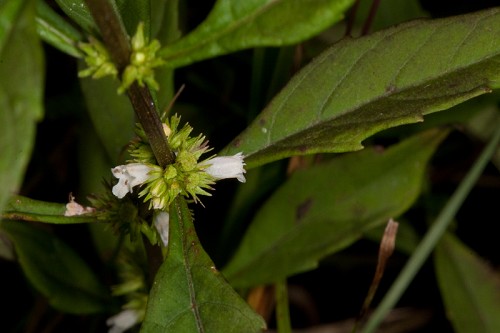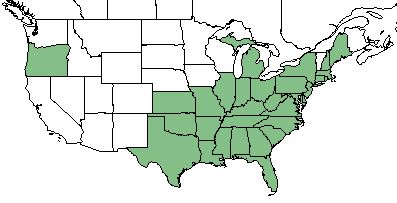Difference between revisions of "Lycopus rubellus"
| Line 35: | Line 35: | ||
In the southeastern and mid-Atlantic United States, ''L. rubellus'' flowers from June through November.<ref name="Weakley 2015"/> | In the southeastern and mid-Atlantic United States, ''L. rubellus'' flowers from June through November.<ref name="Weakley 2015"/> | ||
<!--===Seed dispersal===--> | <!--===Seed dispersal===--> | ||
| − | + | ||
| + | ===Seed bank and germination=== | ||
| + | After submerging seeds in a water filled jar for 130 days, speeds from ''L. rubellus'' still germinated and produced seedlings.<ref name="Shull 1914">Shull GH (1914) The longevity of submerged seeds. The Plant World 17(11):329-337.</ref> | ||
<!--===Fire ecology===--> <!--Fire tolerance, fire dependence, adaptive fire responses--> | <!--===Fire ecology===--> <!--Fire tolerance, fire dependence, adaptive fire responses--> | ||
<!--===Pollination===--> | <!--===Pollination===--> | ||
Revision as of 19:02, 1 February 2018
| Lycopus rubellus | |
|---|---|

| |
| Photo by the Southeastern Flora Database | |
| Scientific classification | |
| Kingdom: | Plantae |
| Division: | Magnoliophyta - Flowering plants |
| Class: | Magnoliopsida - Dicots |
| Order: | Lamiales |
| Family: | Lamiaceae |
| Genus: | Lycopus |
| Species: | L. rubellus |
| Binomial name | |
| Lycopus rubellus Moench | |

| |
| Natural range of Lycopus rubellus from USDA NRCS Plants Database. | |
Common Names: stalked bugleweed;[1] taperleaf water horehound[2]
Contents
Taxonomic Notes
Synonym: L. velutinus;[1][2] L. angustifolius[2]
Description
Lycopus rubellus is a dioecious perennial forb/herb.[2] It produces white flowers.[3]
Distribution
This species occurs from Maine, westward to Michigan, and southward to Florida and Texas.[1] Reports also exist for its occurrence in Oregon.[2]
Ecology
Habitat
L. rubellus is found in marshes, swamp forests, and bottomlands.[1]
Phenology
In the southeastern and mid-Atlantic United States, L. rubellus flowers from June through November.[1]
Seed bank and germination
After submerging seeds in a water filled jar for 130 days, speeds from L. rubellus still germinated and produced seedlings.[4]
Conservation and Management
Cultivation and restoration
Photo Gallery
References and notes
- ↑ 1.0 1.1 1.2 1.3 1.4 Weakley AS (2015) Flora of the Southern and Mid-Atlantic States. Chapel Hill, NC: University of North Carolina Herbarium.
- ↑ 2.0 2.1 2.2 2.3 2.4 USDA NRCS (2016) The PLANTS Database (http://plants.usda.gov, 01 February 2018). National Plant Data Team, Greensboro, NC 27401-4901 USA.
- ↑ Plant database: Lycopus rubellus. (01 February 2018) Lady Bird Johnson Wildflower Center. URL: https://www.wildflower.org/plants/result.php?id_plant=LYRU
- ↑ Shull GH (1914) The longevity of submerged seeds. The Plant World 17(11):329-337.